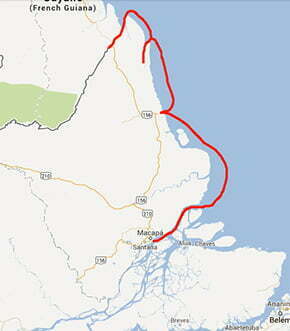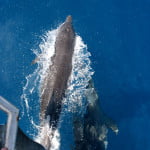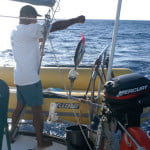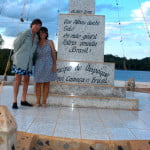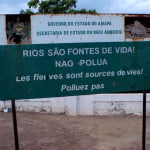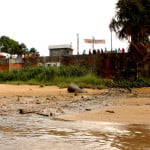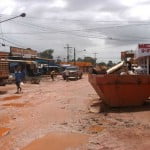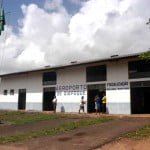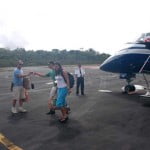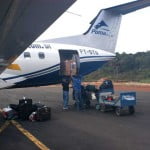17.01.2005
We landed at the small airport of Oiapoque from Macapa at around 11 a.m. During this phase of the Endless Sea Project, our group was composed of Fernando Cerdeira, an experienced sailor and an excellent fellow, reporter Paulina Chamorro and cameraman Rodrigo Cortegiano. Alonso Góes was waiting for us in the boat anchored in front of the city. He was looking forward to our arrival. He was stuck there in the same position since the first days of December when he, Nadia Megonn and I had taken the boat from Natal, in Rio Grande do Norte. In fact, Alonso’s trip had started long ago: in August 2004 he started the long way up along the Brazilian coast, from Santos, the Endless Sea “home”, to Recife. I joined him in September when we participated in the Recife – Fernando de Noronha regatta. We took the boat from there to Natal, and we finally started the long journey – over one thousand miles – from the capital of Rio Grande do Norte to the Oiapoque river, in Brazilian territory, the border with the French Guyana. Eventually, my sailboat was where I wanted for us to start this great adventure. A little bit earlier, in December, we had come here to start the journey down the coast recording the first episodes of the TV series. However, before having sailed the first 20 miles we had our first set-back: the fitting disc of the reversing mechanism of the engine broke down and our trip was aborted. In spite of that, we made good use of our time and recorded two programs in that area under a burning heat. We went back to São Paulo afterwards, edited the material, decided on the last issues concerning the project, the contracts, sponsors, etc. and were ready to start again. Thus, right after the parties of the end of the year we reorganized the crew and came here. We took with us not only the usual luggage, a fridge with food and a big cardboard box, but also a 15 horse stern engine since ours had been stolen a few days earlier, in the Oiapoque river. During this phase, our official cameraman, Feranando Sampaio Barros, from VTF was replaced because of professional commitments by Rodrigo Cortegiano. We finally arrived for a new phase on January 17th in the middle of the Amazon “winter”, a period of torrential rain. Our goal is to go down to Macapa, taking the Cassipore and Calçoene rivers and then stop at Maraca Island before arriving in Macapa, sailing a total of 350 miles.
18-01-2005
We wanted to leave yesterday, but we couldn’t due to problems in setting up the reversing mechanism. We had to sleep another night in Oiapoque, but we were smarter this time, we were not bothered by thousands of starving carapanãs, tiny winged insects craving for our blood, specially at night, at the blessed sleep time: I had brought from São Paulo veils which protect against mosquitoes. These veils were from now on indispensable on board of the Endless Sea. The adventure with a capital “A” started. We left the Oiapoque city to Mont Dargent, a place out of the estuary of the river, on the French side, where we intended to spend the night. But 15 miles away from our arrival, the Endless Sea grounded on a sandbank. The tide was lower and lower , there was no way out: we had to spend the night right there. Some minutes later the sailboat was almost “lying down” sideways, quite heeled. The tide in Northern Brazil is very strong. It goes up and down from 4 to 5 meters and in some places, such as the Maraca Island, there are tides that are 7 meters high. After dinner I went to the cockpit of the boat to enjoy the night and its peculiar sounds, when the first rain drops started to fall. Some seconds later, those drops turned into a heavy storm. Gusts of wind up to 30 knots whipped the boat broadside. At that moment, the sailboat awnings acted as some sort of bulkheads making the boat stuck by the keel on the sandbank heel violently. I had to yell, calling the crew immediately for them put the awnings down in fear that the boat would turn down for good in the middle of the river. With the help of a knife, we cut the cables that attach them to the stays (steel cables that attach the mast), rolled all of them up and stored them in a safe place away from the wind. There was nothing to do but wait. The crew was all together in the living room of the boat, out of their minds because of the heeling, all the hatchways were closed, waiting for the rain and the windstorm to stop their anger. We went on some hours like that until the storm calmed down and we could sleep at last.
19-01-2005
We were up at six a.m. getting ready for breakfast. Since the tide was high again, the sailboat was at it normal position again, floating quietly on the muddy waters of the river. A small fishing boat that was passing by served as pilot. In spite of that we grounded once again some miles down. Nothing serious this time. We waited one hour for the tide to go higher and we started our march towards the mouth of the Oiapoque. Today, we want to follow the contour of Cape Orange and go down the coast about 40 miles until the Cassiporé river were we intend to spend the night. We sailed calmly with weak winds from the East and at just one knot against the current. But it was hard to go out of the mouth of the river.
The depth of that region is very low, the estuary is from to two to three meters deep and its bottom is muddy. We found the same situation all over the contour of Cape Orange which made us sail towards the north on our way out of the river until we reached deeper waters almost invading the French territorial sea and then we came towards the south and started to go down. We sailed at 10 miles away from the coast, with an average depth of 7 meters. If we had strong winds against us, according to our expectations, waves would be high due to low depth and it would be rather chaotic. Fortunately, the wind blew calmly and it made Endless Sea go down this first part swinging very little. We only had set-backs at the end of the day, at nightfall: some fishing boats throwing fishing nets right in our way. Luckily we saw the lights and we confirmed on the radio that their nets were “floating”, that is, on the surface of the water, ready to be twisted by the propeller shaft of our sailboat. The boat was diverted several times in order to avoid them and at around 10 p.m. we were anchored on open sea, in front of the entrance of the Cassiporé river. We were going to sleep right there waiting for daylight to enter the narrows.
20-01-2005
We woke up early in the morning, as usual, as soon as there was daylight. Then, in the middle of our breakfast, the anchor was lifted and we started to enter the narrows . There are mangroves around this part of the Brazilian coast. From the Oiapoque river to Macapá, the relief of the coast is low, with no remarkable points. And this is good. Mangroves are like uterus of the sea: cradle of different species such as mullets, catfishes, sardines, sea horses – recently included on the list of overexploited species – as well as mollusks, shrimps and crabs. They also have another important function: that of protecting the coast line against erosion, winds and the tide strength. This rich ecosystem of utmost importance for sea life is being systematically destroyed. In the South-east it is filled with dirt in order to build mansions for irresponsible people, hotels and tourist complexes. The bay of Angra dos Reis, in Rio de Janeiro, is a good example of this criminal occupation. And in the North-east it is being filled with dirt with the complicity of the Federal Government that has given these public areas to breed shrimps. It is true that exporting shrimps has brought foreign exchange credits for the public treasure, but the results may be disastrous in the long term. In 2003, Brazil exported 60 thousand tons and collected 240 million dollars . Most of the fishes come from cultures in the mangroves, but this affects the ecosystem. Besides filling with earth the mangroves, the culture of shrimps in captivity has brought other serious damages such as the extinction of the uça crab from the mangroves of the North-east. Researchers found out that the death of the crabs is caused by the fungus from the Azcomycota phylum. Lodged in the crab, the fungus inhibits its motor capacity to such an extent that it prevents it from moving to get food. That’s why part of the uças die from hunger. Researchers from USP believe that these funguses proliferate in the waters polluted by the culture of shrimps. This idea comes from the fact that the disease is present exactly where the culture of shrimps started…
The fact is that today the uça isn’t found anywhere in Bahia, Sergipe, Paraíba, nor in the south of São Paulo. But there is more: according to the biologist Fernando Cerdeira, a crew member of this phase of the Endless Sea project, the shrimp culture introduced in Brazil a new species of the crustacean known as “paneus vanamei” from the Pacific. The producers found out that this species has greater productivity because it grows faster. And as soon as this news was spread, most producers preferred the alien shrimp and today 60% to 70% of what is caught comes from this species. The problem here is that this type of shrimp brings an exotic virus (very common for this species) and it may infect and decimate our native stocks… As we can see, our coast and sea life is full of threats. This is one extra reason to praise this coast of Amapá, surrounded by mangroves scarcely touched from Oiapoque to Macapá. Going back to our navigation: we entered the narrows of Cassiporé quite early. Once again, depth here is very low, very often it is below 2 meters, and fortunately there is always mud at the bottom. Because very often the extremity of the keel of Endless Sea served as a plow, making furrows in the soft mud… when the situation got worse, the depth getting lower and lower at every mile, we saw a fishing boat from afar. We decided to put the rubber boat down and meet the fishermen and know if they could serve as pilots. Fernando and Rodrigo were on board and came back with the news: according to what they said, the relief of the bottom was always like that, sometimes deeper, but with no bigger obstacles. We could continue, there was nothing to fear. The fishermen were from Belém, in Pará, they had come in a tiny little boat, following a bigger one, and would stay in Amapá for a month and then return.
The problem was that their engine was “locked”, the had been grounded for a couple of days and they would go on like that for a month waiting for the big boat to tow it back for about 600 miles! They had little food and were quite discouraged. To thank them for their help we gave them some chocolate, some packets of rice and we continued on our journey. We made our way up the Cassiporé river, exploring its borders, expecting to reach the Maruani lagoon, some miles up the river. There are manatees in it and flamingoes around it. We passed by the small village of Tepereba, very poor and we went on up until we were blocked by the low depth. Once again the Endless Sea’s keel started to touch the river-bed lightly. We turned back, looked for a deeper place and anchored. We took the rubber boat and went to a caboclo’s house (a person who is half white, half Indian) on the shore of Cassiporé to get some information. Mr. Antônio told us it was impossible to reach the lagoon through a small river arm near to where we were. We tried anyway. Rodrigo, the cameraman, and I entered that small river arm in our rubber boat and went on for half an hour until it was so narrow that we couldn’t go any further. What a pity! We weren’t able to shoot those beautiful birds so rare on the north-east and south-east coasts. Flamingos are one of the species on the edge of extinction of the Brazilian fauna. No wonder! When there were only Indians here, Flamingos were already implacably hunted. At first by themselves, because they wanted their red feathers to make adornments and plumes.
Later, when Europeans arrived, the situation worsened. With the colonization, the progress and the massive occupation of the shore, there aren’t many places left where this bird can be seen. Guarapari in Tupi means “guarás’ meeting”. However, if you go to Guarapari, on Espírito Santo’s shore, you won’t see any single bird of this species, it’s been a long time since its extinction…annoyances of progress. After having failed in our attempt to reach the lagoon, we went back to Tepereba, right after the estuary of the Cassiporé river in order to interview some local people as well as to look for the person from Ibama in charge of Parque Nacional do Cabo Orange since it is headquartered there. No chance. The headquarters was closed, nobody to talk to, just some local people, especially fishermen. We talked to some of them and we witnessed the drunkenness of four other men who were in the only bar of the neighborhood. I was forced to take pictures of the group and I could only leave the bar when I promised to send copies of the pictures to each one of them in the Oiapoque’s district. We slept anchored in front of the village under a lot of rain.
21 – 01 – 2005
We left the estuary early in the morning and we sailed southwards again to the Calçoene river 80 miles down. We sailed calmly, but the wind was a bit stronger. The wind outside was blowing east at 12 knots. We raised the mainsail and the mizzen sail (the smaller sail) and with the gear at low rotation we sailed at a speed of 10 knots since there was a favorable stream during part of our route ! Again we sailed alongside the coast at an average depth between 6 and 8 meters. When most of the sailors I know were told I intended to bring my sailboat here to the northernmost part of the country they advised me emphatically not to do so. According to them, I would have to face “tremendous setbacks” to sail downwards “always with contrary winds and streams”.
They are used to sailing away from the coast, to the Caribbean Sea, or coming from it. That’s why they take a more oceanic route. I was sure that sailing near the shore could be different and when I talked to one of them, who by the way is aboard today, Fernando Cerdeira, I was told that a guide written by an American sailor confirmed my assumptions: closer to the shore, yes there are favorable streams. Today, we are proving this thesis once again. At four a.m. we were in front of the estuary of the Calçoene river and for safety purposes I preferred to enter it with daylight. We anchored out and went to bed until dawn, two hours later.
22-01-2005
The Calçoene river is emblematic for people from Amapá, it is historical. This is where for the first time gold was found in this state. It was at the end of the nineteenth century and as soon as the news spread, there was a gold rush and of course all the problems it brings. As far as Amapá is concerned it was rather serious, even French people from the Guyana invaded the state, and “occupied” the region, founding here the Independent Republic of Cunany, governed by the novel writer Jules Gros, member of the Commercial Geographic Society of Paris. There was such a great misunderstanding that Macapá was attacked by the French. That’s why the area between Calçoene and the Oiapoque river was a neutral no man’s land until a treaty mediated by Switzerland in 1900 gave the region back to Brazil. This was the very same river we were entering and we sailed in it for about 10 miles with a good depth. We were surprised by the favorable situation when suddenly the keel hit the bottom. We were grounded once again. And the tide was getting lower. In a few seconds the river was completely dry. This time Endless Sea was lying aside. It was bad (see the pictures) and the crew was scared. It was 10 a.m. We got off on the dry river-bed, disoriented and we just wanted to have a look and rest since being aboard was impossible. Only a juggler would be able to. After being sure the boat would not turn down, we relaxed and decided to have a good barbecue. A piece of beef was on the grill while Alonso, like a rope-walker hanging in the middle of the room, made rice. We ate and waited until the tide was higher. We decided reporter Paulina Chamorro, and cameraman Rodrigo Cortegiano would go back from Calçoene to Macapá by bus.
This adventure had been enough for them and they also had to shoot the city, all the way to Macapá and wait for us to shoot the arrival of the boat entering the Amazon river. Once again I took the rubber boat and took the two of them to the city half an hour away from where the boat was stuck. I went back and found Marzão upright, a little bit mad at me, it is true, but she was up. When I arrived she looked at me a bit angry saying: skipper, this is not fair. I’m a boat, not a car… I need water! I learned the lesson. I will treat my boat well, after all there are almost 8 thousand kilometers to go down the coast… At 5 p.m. we left the estuary. The sea was calm, a few waves, weak wind. We went straight forward to Macapá – 200 miles – we didn’t pass by the Maracá island where at first we intended to stop. We weren’t able to because of the pororoca, a tupiniquim phenomenon when the high tide joins the waters of the rivers, creating a “tsunami” that swallows up what is on its way. And we had already been very lucky. It was not worth to take more risks at that point. Now, at 11:30 p.m., we are more than 30 miles away from the mouth of the Calçoene river, getting ready to sail alongside Maracá Island. Out there the moon –it will be full on the 25th – is Fernando’s companion – it is his shift. Alonso is sleeping in the cabin of the bow. I am getting dizzy with this endless writing here on the plotting table. It’s time to stop. There is more tomorrow. 23-01-2005 We had a wonderful night yesterday, with a big moon growing in the sky and a very calm sea and many stars. At 2 a.m. I replaced Alonso, who was on the previous shift, I took care of the rudder until 4 a.m. No navigation problem. We passed around Maracá Island 8 miles away from it. We couldn’t even see it, or hear the sound of the “great explosion” or pororoca (in tupi-guarani the Brazilian native language before colonization). The only problem of the night was to see once more the great amount of boats that trawl. This is a very harmful way of catching fishes as far as the environment and the marine diversity are concerned. These trawl-nets not only drag everything they find on their way but they also rake and destroy the bottom of the sea. According to an oceanographer from São Paulo, Roberto Ávila Bernardes, the fauna that comes with it and is caught is around 80%.
This means that for each 10 kilos of shrimp, the fisherman also catches up to 8 kilos of additional fauna that is thrown away back to the sea completely dead. The situation is so serious that the governments of some countries such as Costa Rica and some NGOs are putting pressure on the UN to forbid the trawl at the bottom of international waters. In spite of all these evidences and prohibitions (without inspections) near the coast, here in Brazil this type of fishing still is a current practice and nobody cares. During our journey, we have seen all types of fishing boats, with nets, fishing lines and trawl-nets, from the northernmost part of Brazil to here, near the mouth of the Amazon river. Until when? The scientific community has already advised the Brazilian government to the fact that most of the species that are fished on our coast more often, from Bahia to the south, have already been overexploited and at risk of extinction. Besides there is the fact that this occurs all over the world. Fishing is rarely a self-supporting activity. According to FAO’S latest data, an organization linked with the UN, half of the world’s fishing reserves have already been overexploited and 25% are at the limit of their capacity. There is more. Another study carried out by the UN Program for the Environment shows that in 15 years the amount of dead sea zones has doubled for lack of oxygen. This also happens in South America, in Australia, in the China sea, in the Baltic, in the Black Sea, in Japan, etc. These zones range from 1 square meter to 70 thousand! This is caused by human drains, industrial pollutants and fertilizers used in agriculture. It is a very serious situation. Even here in the northernmost part of Brazil, in one of the most preserved states as far as its vegetation is concerned, there are significant threats and Amapá has a deforestation rate of 10% – more for being rarely reached and for its low rate of inhabitants than for a matter of environmental awareness. One of these threats is the lack of basic sanitation. There are open drains. In the district of Oiapoque we could see that the waste of its population (over 12 thousand inhabitants) is thrown into the river, in spite of the countless signs put by the state government and by the city hall (see pictures) in Portuguese and French asking local inhabitants to protect the river “source of life”. As an example to be followed, the district administration throws in it all the waste its inhabitants produce. The smell is fetid and it is similar to that of Tietê in São Paulo. It’s absurd! And it is the same all over the state. In the capital, Macapá,
ONLY 8% of the houses have drainage systems. But again, the harm comes from the public administration that insists but does very little, as it is the case with the signs to protect the Oiapoque river. There are about 300 thousand people living in Macapá and the drains go straight to the Amazon river. In Manaus, the situation is worse. There are about one million and six hundred thousand inhabitants in the city and only 15% have drainage systems. The rest throw their waste into the river. But there is more. In Amapá, the rivers are polluted by heavy metals, specially mercury, used to extract gold. But the manganese, kaolin and oil mining also pollute the rivers. Not to mention the industrial pollution caused by ALUNORTE, an aluminum export company. There are some other additional threats: the expansion of sugar cane, polluting significantly mangroves and rivers because of the waste of redistillation and the most recent one: the pig-iron plants that have been built in Macapá with their ovens being fed day and night all year long by vegetal coal, that is, from the forest. By the way, these sad data make me think of something worse. I read recently in the papers that the Lula administration in 2004 invested in urban environmental sanitation an insignificant amount of money. It was less than the amount paid for the new presidential airplane. This costed for the public treasure the bagatelle of 46,7 million dollars whereas the amount of money given by the president for sanitation was 53,6 million reais. Now I think you can understand the sign from the district administration of Oiapoque asking to protect the river and polluting it simultaneously, after all, here in Brazil the example comes from the, don’t you think? Well, now it is 9:30 p.m. we are still in the northern hemisphere. I look at the GPS here in front of me and I see: our latitude is 00°42’N and longitude 050°10W, therefore, we are in the north channel, about 50 miles from Macapá, right in the mouth of the Amazon river and sailing is really calm now. The boat swings so gently that I don’t make mistakes while I’m typing my logbook on the laptop, Semp Toshiba of course. The only concern is the boats coming in and going out and the sandbanks caused by the sediments dragged by fresh water and deposited at the bottom of the sea. It is weird however to sail in this huge sea from Oiapoque to here and always see this brown water, really muddy. Every day when I leave the cabin and look at the sea I am surprised to see this huge thing all brown. The explanation is very simple: this colossal river throws in the Atlantic 250 thousand cubic meters of water per second. This means that at every 30 seconds there are 6 million liters of fresh water in the ocean thrown by this dragon called Amazon that vomits water instead of fire. I’m going outside to smoke a cigarette, I’ll be back in a minute to finish my report.
24-01-2005
We are in the middle of the Amazon and everything here is superlative, the problems, the virtues. Do you want to see? This is the biggest forest of the world. One fifth of all the fresh water in the planet is here. It is the biggest hydrographic basin in the world with 20.000 kilometers of navigable rivers at any time of the year. This area is so rich that it has the greatest amount of mammalian species, of fresh water fishes and the greatest variety of plants. More than 30% of all the existing biological diversity is in the Amazon. Twenty million people live in its surroundings, in an area that is equivalent to 61% of the national territory. Despite the great devastation, 80% of the forest is still alive, but with many threats: here we have the lowest urbanization rate and the per capita income is far below the Brazilian average. US 1.754.00 compared to US 3.165.00. There is an increasing deforestation and the inhabitants’ standard of living is miserable, and approximately 15% of the wealth produced is owned by 1% of “elected” people – according to a researcher from the Amazon’s Environmental Research Institute, IPAM, Paulo Moutinho, not to mention other extremely serious issues. This researcher, Paulo Moutinho, put emphasis on the fact that the development model adopted in the last 30 years made the population poorer, created a greater income concentration and permitted the loss of environmental assets. Important businessmen from the mining, wood extraction and building fields are the only ones to take advantage of the situation. There are also landowners in the field of cattle raising or grain production who benefit from the situation. A different kind of development model is necessary. The one that was adopted has not improved the standard of living of the population and it has proved ineffective as far as the sustainable development is concerned. And we, from the Endless Sea Project, will be able to register and observe very closely all this issue since we will go round Marajó Island from the inside, that is, we will be between the island and the continent, on our way from Macapá to Belém.
We will be visiting many places of the island as we pass by the smaller and more typical villages. After that we will take some of the Amazons’ and Pará’s arms and eventually we will sail alongside the coast of Pará going to every possible village until São Luis do Maranhão and on our route we will be contacting local inhabitants in order to see their social condition. Up to the present moment, we have seen poverty everywhere. The researcher is right when he says a new development model is necessary, one that gives priority to men, after all it is not possible any more to accept a population in such a miserable condition in such a rich area. It simply doesn’t make sense. This shows something is wrong. But our concern now is to arrive in Macapá, the end of this stage. We have to take all the material we got, films, pictures, testimonies, tapes and texts to São Paulo. Part of it goes to the site of the project, part of it goes to Cultura television and radio and when everything is ready for broadcasting it is time to start a new stage, form Macapá to Belém. This arrival has been hard. There are barely 40 miles left to Macapá, and we are running out of diesel. This results from going up at random to many rivers and we didn’t take that into account. Now, we will have to use the sails, which wouldn’t be bad if there was wind, but there isn’t any. So when it blows a little, we open the sails and benefit from the wind the best we can and when it stops we drop the anchor not to go backwards due to the low tide. We wait until it blows more or until the tide is higher. Then we sail a little bit forwards and that’s the way we keep on moving, fighting for each mile. It is 4 a.m. and I’m happy: we have been sailing well since midnight, the wind blows and the tide is favorable. We are quite near Macapá, it is 20 miles away from us. In the morning we will be there. During these seven days, we have sailed about 350 miles, shooting the most unknown coast of Brazil, the Amapá coast, with its mangroves, rivers, forests, flora and fauna scarcely known and registered. We entered its most important rivers, except Araguari, we avoided it because of its strong pororoca. If our boat had been caught by it, everything would be over now. It would be the end of the project, of the television program, and that of my faithful companion of so many journeys, the Endless Sea, and I can’t take this risk. Eventually, at 10 a.m., after having sailed across the greatest river of the world, we anchored in front of the city of Macapá. Right after a motor boat from the Port Authorities came to welcome us. As soon as I decided to start by this area, I got in contact with my friends from the Brazilian Navy and asked for their support. I’m aware of the risks inherent in the project, the sea, but I also know those that result from the stupid violence we have to face today. It was right here that one of the greatest icons of the world sailing lost his life: Sir Peter Blake, when he reacted to a robbery in Santana, near Macapá, he was shot dead .
So, I talked to Admiral Marcus Vinicius, from the Fourth Naval District, in Belém, and asked him if my sail-boat could be anchored there under the Navy’s responsibility and he promptly accepted our request. I was told to contact the commander of the Navy’s Port Authorities in Santana and as soon as we arrived, he joined us and escorted us until the boat was anchored at the Navy pier, next to the port of Santana. That’s where Endless Sea and my fellow, the executive officer, Alonso Góes, are. He is one of the most experienced sailors in Brazil, a very brave sailor, competent, without him I would never dare go where I go, besides, he loves his profession, like those from the old times, Alonso. That’s it. Today we finished the first stage of the dream that is becoming true, to plot, to register in film, pictures, tapes, every mile, every village, every bay, river or creek of the Brazilian coast. And it is much more important to make this material available for all those who want it, through a weekly program on TV Cultura broadcasting it all over the country, every Sunday at 6 p.m. as well as giving bulletins for Radio Cultura AM and FM and making all this information available on the site. This means that many people will see and get to know one of the most beautiful coasts of the world, although it is treated badly and very often disrespected and unknown above all. Since only lack of awareness can justify such a harmful occupation.
I hope that through awareness, and television helps a lot, more people can take care of his/her duty better: the government either planning well for a better occupation or making a more and better infrastructure available, and the citizens either not building where they are not supposed to, not polluting the area where they are or putting pressure on the public authorities every time they do nothing or when they are incompetent. Our next stage will be in February, we will leave Macapá and go to Belém do Pará. It will be an interesting trip. We will cross 300 kilometers of the mouth of the Amazon river and will go between Marajó Island and the continent, through linking arms, channels and rivers, stopping in every village, to see personally the conditions and give voice to those who live there, showing every possible detail. You can follow us through the site, TV or radio. Write, criticize, ask, give suggestions. We do what we do because the Brazilian coast, and everything on it, is a patrimony – seriously threatened – not only ours or belonging to our generation, but it is the whole world’s patrimony and it belongs to future generations too. It is time to change the way the seas are governed. They are all closely connected, they don’t belong to a single government or country, but to Humanity. 71% of the surface of the planet is composed of oceans, and it is the most delicate part, where 90% of the whole marine life is originated and 50% of the GLOBAL BIOLOGICAL DIVERSITY is the shore: the place where the water meets the earth. To treat it badly, as has been the case, by ignorance or omission means to sentence sea life to death. Now you are invited to follow our next stage.
See you soon


